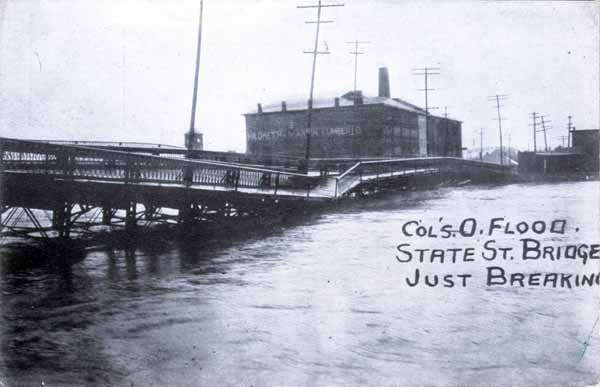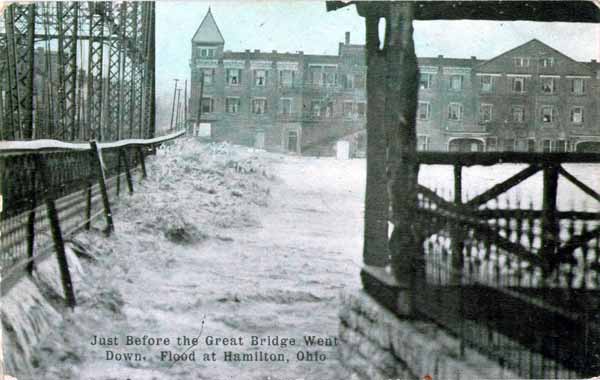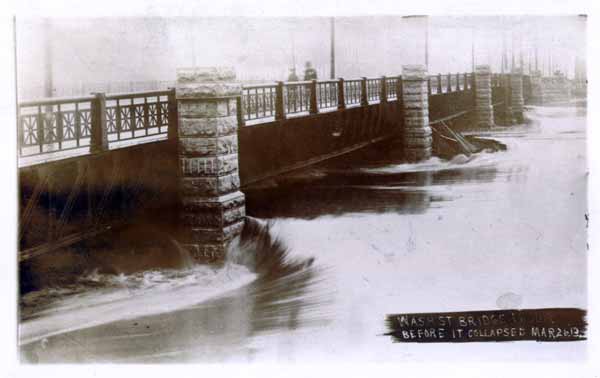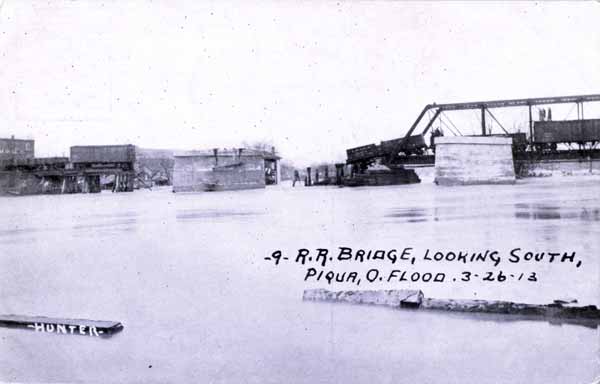The Floods of 1913
Why the Bridges Failed

State Street Bridge just as it failed, Columbus, Ohio
This unused postcard has the printed text...
Published by Haenlein Bros., Columbus, Ohio
Several factors determine why some bridges collapse during a flood. In the floods of 1913 it was often the sheer weight of water and debris building up against them that caused them to fail. Stone or concrete bridges stood more chance of survival than an iron or steel one. Bridges with single spans will survive a flood that will collapse a bridge with several spans on piers. Bridges with piers built on deep piles will survive longer than bridges built on shallow piles in the river bed. Bridges with a higher deck clearance above the water will survive longer than one with a lower lying deck.

Great Bridge just before it collapsed, Hamilton, Ohio
This postcard, posted in Hamilton on April 23rd, 1913 has no other printed text.
There is an effect known as "scouring" where fast running flood water will actually gouge out large amounts of the riverbed directly behind and downstream of the piers it stands on. The piers themselves have to stand up to a lot of water pressure and may fail, especially if they are on shallow piles and scouring has occured. There is a phenomenon called backwater where water will tend to be deeper on the upstream side of a bridge than on the downstream side due to the dynamics of water flowing through a constricted space. Backwater may be several feet in height and extend for a considerable distance upstream. Excessive backwater will both cause flooding upstream from the bridge and also increase the amount of scouring taking place at the bridge itself.

West Washington Street Bridge, Indianapolis an hour before it collapsed
This unused postcard has no other printed text. It shows the phenomenon known as backwater very well.
Debris building up around the piers acts as a dam and increases the pressure against them. Once water has reached the deck then the pressure is very much increased, especially as even more debris will now be trapped against the bridge. The flood water may also wash away the area of the river bank that the ends of the bridge sit on.

Driftwood against Canal Bridge
This unused postcard has no other printed text but does have a hand-written note saying "1913 Flood in Ohio". It wasn't just what we would think of "debris" these bridges had to cope with but entire buildings were being swept against them.
In an effort to try and save save at least some of the bridges, where it was practical, train carloads of coal or other material were parked on top of them to add to the weight. Sometimes this worked and sometimes it didn't. Sometimes the damming effect of the bridge would cause so much water to build up in front of it that the levees on either side of the banks were threatened. In order to save the levees some bridges were dynamited.

Railway Bridge looking south, Piqua, Ohio - March 26th, 1913
During the floods, many bridges had railway freight cars parked on them to help prevent the bridges being swept away. Sometimes it worked, sometimes it didn't!
This unused postcard has the printed text...
9
Hunter
Published by Haenlein Bros., Columbus, Ohio
Sources & Further Reading:
1913 Dayton Flood and the Birth of Modern Flood Control Engineering in the United States
1913 Tornado at the Malleable - pictures of the tornado damage at Albion, Michigan
America's Greatest Flood and Tornado Calamity - Thomas Herbert & J. Martin Miller, published by Thomas Morrison, 1913
BBC H2G2: The Dayton Flood of 1913
Berrien County website - details of the 1913 Baroda, Michigan tornado
Columbus, Ohio: Flood from Photographs - unknown publisher
Dayton Flood - Dayton Flood book Co., 1916
Encyclopedia of Indianapolis: Flooding and Flood Control - David J. Bodenhamer and Robert Graham Barrows. Published in 1994
Falls City Engineers - A History of the Louisville District Corps of Engineers United States Army - Leland R. Johnson, published in 1974
Flood at Hamilton, Ohio: Historic Disaster Illustrated
Flood Views of Marietta, Ohio - Published by Emmel & Howard, 1913
Forgotten Waters: Indiana's Great Easter Flood of 1913 - Trudy E. Bell, Traces.Magazine of the Indiana Historical Society, Spring 2006
GenDisasters - Search the site for things like 1913, flood, and tornado to find some interesting articles.
Goodbye, The Levee Has Broken (Gone) - A PBS / ThinkTV / Montgomery County Historical Society video - The story of the flood in Dayton, Ohio
Great 1913 Flood , Dayton, Ohio - K. M. Kammerer, published by the Speciality Photograph Company, 1913
Great Dayton Flood of 1913 by Trudy E. Bell, published by Arcadia Publishing in the Images of America series, 2008
Historic Indianapolis: Postcards from the Great Flood of 1913
Historic Omaha (Internet Archive) - details of the Nebraska / Iowa tornadoes
Historical Souvenir of the Fremont Flood by Frank Finch, published by Finch Studio, 1913
Jesse A. Grice; Sheriff and Mayor, 1852-1915 (Internet Archive) by Allen County Public Library, Published in Fort Wayne, 1957
History of Cass County, Indiana edited by Dr. Zehu Z. Powell, published by the Lewis Publishing Company, 1913
Indiana Album - An interesting site. As with other collections search for 1913, flood and tornado
Lane Libraries of Ohio - Some previews of books about the 1913 floods
Lest We Forget, Miami Conservancy District, 1947
Martinsville: Lore and Legend (Internet Archive)
Mid-South Views the Floods of 1912 and 1913 by Bobby J. Williams
Monthly Weather Review - A fantastic collection from the American Meteorological Society. A useful and fascinating resource
Ohio's Yesterdays: David Chambers and the Great Dayton Flood
Omaha Cyclone in Pictures - Mogy Publishing
Our National Calamity of Fire, Flood and Tornado- Logan Marshall, published by L. T. Myers, 1913. One of the least hysterical books published shortly after the floods.
Pennsylvania Lines West of Pittsburgh: A History of the Flood of March 1913 - C. W. Garrett, published by the Pennsylvania Company, 1913
Photographic Story of the Flood in Dayton, Hamilton and Cincinnati - O. Middendorf, published by S. S. Kresge Company, Detroit, Michigan
Photographic Story of the Fremont Flood, Published by K. & C. Co., Fremont, Ohio
Pictorial History of the Great Dayton Flood - Nellis R. Funk, published by Otterbein Press, 1913
Second (!) Bridge from Indianapolis over the White River - A bit of history of the West Washington Street Bridge and the Uneeda Biscuit factory, Indianapolis
Sixteen Views of the World's Greatest Flood at Dayton, Ohio - published by Hyre & Wierer Photographing Co., Dayton
Story in Pictures of the Omaha Cyclone, 1913
Story of the Great Flood and Cyclone Disasters - Thomas Russell, published by Thomas Morrison, 1913
Story of the Omaha Tornado in Words and Pictures - Miles Greenleaf and Carl G. Eddy, published by John L. Giddon, 1913
Taking Engineering by Storm - Trudy E. Bell, an overview of the storms and later flood control measures
Terrible Flood of 1913 published in 1913 by The Pfeifer Show Print Company, Columbus, Ohio
The floods of 1913 in the Rivers of the Ohio and Lower Mississippi Valleys - Alfred Judson Henry, published by the Governement Printing Office, Washington D.C.
Tiffin is Flood Stricken! (Internet Archive) - Sunday, March 30, 1913 edition of the Tiffin Daily Tribune and Herald
Tornado Project: The Most "Important" US Tornadoes by State
Track of the Tornado - Published by The Omaha Bee
Tragic Story of America's Greatest Disaster - Marshall Everett, published by J. S. Ziegler, Chicago, 1913
Turbulent Times in Terre Haute: 1913 Tornado and Flood (Internet Archive)
The 1913 books produced after the floods contain a lot of stories about the disaster but were written in a sensational tabloid style and the number of deaths and injuries are greatly exaggerated. Although factually unreliable they do contain some very interesting images.